Today was a truly liberal arts experience. We spent the morning thinking about proposed solutions to slow glacial melt and climate change, and got to see some firsthand. On the Vadre Pers Glacier, we saw one method of slowing glacial melt: covering the glacier with a white, insulating blanket. This helps to slow glacier melt by providing insulation to the cold ice surface, as well as increasing the reluctance of sunlight. The reflectiveness of the white surface keeps the surface underneath cooler, since not much heat is absorbed. We then hiked along a ridge to capture a view of the Morteratsch Glacier in the valley below, the same glacier that we hiked to the tongue of yesterday. Another method is currently proposed to slow the melting of the Morteratsch Glacier: using snow making technology to create snow on the glacier in the late spring. This will provide a buffer to snow-melt in the hot summer months, because there will be more snow at the beginning of summer. As a consequence, the glacier will not recede as much because of the added snow input. Both of these methods are considering small scale geoengineering methods, where humans deliberately intervene in Earth’s climate system to slow the impacts of climate change. These methods are often controversial, because there are differing opinions as to what extent humans should alter natural systems, despite their efforts to slow human-induced climate change.
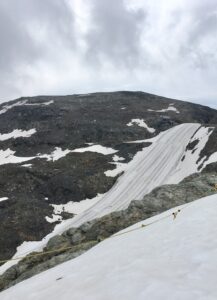
The blanketed glacier surface on the Vadre Pers Glacier
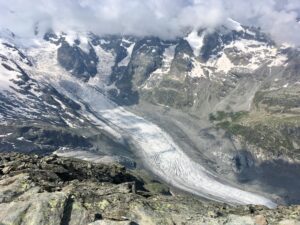
Our view of the Morteratsch Glacier, where snowmaking is proposed
We then had a class discussion about proposed geoengineering methods to slow climate change on a global scale, after looking at the two small-scale examples on the glaciers. There are 2 main categories of global geoengineering methods that are proposed: 1) reducing the amount of incoming solar radiation that reaches the Earth; and 2) removing carbon dioxide from the atmosphere. Injecting aerosols into the atmosphere can reduce solar radiation reaching Earths surface (mimicking a volcano eruption) and therefore cool temperatures on Earth, as the aerosols will prevent some sunlight from reaching the surface. Another method that has been explored to decrease solar radiation is sending large mirrors into orbit around the Earth, which will also reflect the suns rays. Two other methods have been proposed to remove carbon dioxide from the atmosphere: 1) using large machines that sequester carbon from the atmosphere and store it underground; and 2) fertilizing oceans with iron to foster algae growth, which thereby removes carbon dioxide from the atmosphere through photosynthesis. As a class, we could see both sides of the geoengineering argument. On one hand, using these methods will slow down the impacts of climate change, and allows us more time to search for other long term solutions. But on the other hand, these methods are risky because there could be unknown consequences at such a large scale. Furthermore, these geoengineering solutions only are responding to the impacts of climate change, and not the root cause of the problem itself.
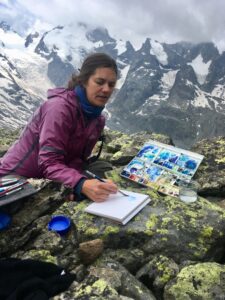
Betsy’s watercolor tutorial
We spent the rest of the afternoon looking at glaciers through a different lens. During our hike we stopped and Betsy gave a watercolor tutorial. She made it look really easy. Effortlessly depicting the glacier landscape. With varying levels of success, we followed suit completing a quick piece for only 20 minutes. We then gathered our supplies, completed the hike, and began a painting for a longer time of a smaller part of the glacier. We focused on specific elements such as crevasses or a piece depicting other interaction of glaciers and climate change. It was really cool opportunity to see glaciers differently. Instead of identifying glacial processes and the role of glaciers in the hydrologic cycle, we focused on light, texture, and how to share emotions about climate change without any words.
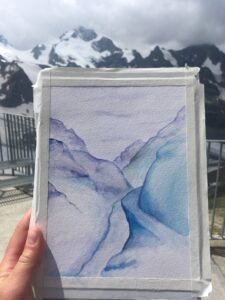
Ester’s mountain masterpiece
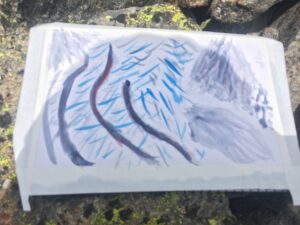
Jeff mountain masterpiece